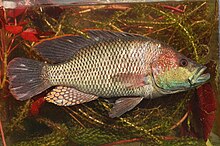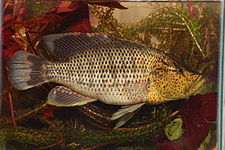| Serranochromis | |
|---|---|

| |

| |
| S. jallae (above) S. macrocephalus (below) | |
| Scientific classification | |
| Domain: | Eukaryota |
| Kingdom: | Animalia |
| Phylum: | Chordata |
| Class: | Actinopterygii |
| Order: | Cichliformes |
| Family: | Cichlidae |
| Tribe: | Haplochromini |
| Genus: | Serranochromis Regan, 1920 |
| Type species | |
| Chromys thumbergi Castelnau, 1861 | |
Serranochromis is a genus of relatively large, robust cichlids from freshwater habitats in mainland Southern Africa, ranging as far north as DR Congo and Tanzania, with the highest species richness in the upper Zambezi, Okavango and Congo basins. They are typically known as largemouths or, especially among fishers, breams (although unrelated to other fish known as "bream"). Serranochromis are mostly piscivores and they are important in local fisheries.
Habitat
Serranochromis live in a wide variety of freshwater habitats, ranging from shallow, heavily vegetated waters to deep, open waters. This includes main river channels, backwaters, floodplains, lakes and lagoons, but only a few of the species have been recorded in fast-flowing waters. Smaller Serranochromis tend to avoid open waters if common tigerfish are present, but the largest Serranochromis are generally too large to be considered typical prey to common tigerfish and they co-exist in the same habitat.
Appearance and behavior
Depending on the exact species of Serranochromis, the maximum length is between 25 and 56 cm (10–22 in), and the largest species can reach up to 7 kg (15 lb) in weight.
They feed almost entirely on small fish, especially other cichlids, cyprinids, elephantfish and squeaker catfish, but some will also take invertebrates. Although all will take most types of small fish, there is a level of specialisation: S. altus is nocturnal or crepuscular, similar to its main prey, the elephantfish. S. angusticeps is well-camouflaged among dense aquatic vegetation, which allows it to slowly approach its main prey, small cyprinids. S. jallae has a particularly robust mouth and teeth suitable for dealing with its main prey, the spiny and heavily armored squeaker catfish (however, young S. jallae mostly feed on small cyprinids and aquatic insects).
Serranochromis are mouthbrooders and most—if not all—species are seasonal breeders that begin spawning around the end of the low water period. They generally reach maturity when two or three years old.
Fishing and conservation status
Serranochromis support important commercial and subsistence fisheries, and are also valued as game fish. S. jallae has been introduced for fishing to some places in Southern Africa outside its original range and in these places it can have an adverse effect on small native fish, especially cyprinids. Conversely, S. robustus has declined drastically in its native range due to overfishing, leading the IUCN to rate it as critically endangered. S. meridianus is considered endangered due to habitat degradation and the poorly known S. janus is considered data deficient (available information is insufficient for determining its conservation status), while the remaining species in the genus are least concern (not threatened).
Species and taxonomy

 S. altus (right) and S. angusticeps (left) were confused until 1991 and their morphology is quite similar, but they do differ in certain morphometrics, color, habitat preference and feeding behavior
S. altus (right) and S. angusticeps (left) were confused until 1991 and their morphology is quite similar, but they do differ in certain morphometrics, color, habitat preference and feeding behavior
According to FishBase, there are currently 11 recognized species in this genus:
- Serranochromis altus Winemiller & Kelso-Winemiller, 1991 (Humpback largemouth)
- Serranochromis angusticeps (Boulenger, 1907) (Speckleface bream, thinface cichlid)
- Serranochromis jallae (Boulenger, 1896) (Nembwe)
- Serranochromis janus Trewavas, 1964
- Serranochromis longimanus (Boulenger, 1911) (Longfin largemouth)
- Serranochromis macrocephalus (Boulenger, 1899) (Purpleface largemouth)
- Serranochromis meridianus R. A. Jubb, 1967 (Lowveld largemouth)
- Serranochromis robustus (Günther, 1864) (Yellow-belly bream)
- Serranochromis spei Trewavas, 1964
- Serranochromis stappersi Trewavas, 1964
- Serranochromis thumbergi (Castelnau, 1861) (Brownspot largemouth)

A few other, possibly undescribed species are known from the genus. Furthermore, the taxonomy of the S. macrocephalus and S. robustus complexes is not fully resolved. Based on mtDNA, both are polyphyletic. A partial solution to the S. robustus complex has been to recognize jallae as its own species, instead of the traditional treatment where it was considered a subspecies of S. robustus.
Additionally, Sargochromis (the "smallmouths"; found in the same overall region and mostly feed on invertebrates) has been considered a subgenus of Serranochromis, but today it is generally recognized as a separate genus. These genera, along with Chetia, Pharyngochromis and others, form a group sometimes known as the serranochromines or Serranochromini. How many other genera that are included varies, with some defining the group relatively narrowly and others broadly. Genetic evidence indicates that several genera in this group, including Serranochromis, are not monophyletic.
References
- ^ Froese, Rainer; Pauly, Daniel (eds.). "Species in genus Serranochromis". FishBase. October 2019 version.
- ^ Winemiller, K.O. (1991). "Comparative ecology of Serranochromis species (Teleostei: Cichlidae) in the Upper Zambezi River floodplain". Journal of Fish Biology. 39 (5): 617–639. doi:10.1111/j.1095-8649.1991.tb04393.x.
- ^ Hansford-Steele, B. (2013). African fly-fishing handbook: A guide to freshwater and saltwater fly-fishing in Africa. Struik Publishers. ISBN 9781432302290.
- ^ Winemiller, I.K.O.; L.C. Kelso-Winemiller (1991). "Serranochromis altus, a New Species of Piscivorous Cichlid (Teleostei: Perciformes) from the Upper Zambezi River". Copeia. 1991 (3): 675–686. doi:10.2307/1446393. JSTOR 1446393.
- Thorstad, E.B.; C.J. Hay; T.F. Næsje; B. Chanda; F. Økland (2005). "Movement and habitat utilization of nembwe, Serranochromis robustus (Gunther 1864), in the Upper Zambezi River". African Zoology. 40 (2): 253–259. doi:10.1080/15627020.2005.11407324. S2CID 84080641.
- Froese, Rainer; Pauly, Daniel (eds.). "Serranochromis thumbergi". FishBase. October 2019 version.
- Gratwicke, B.; B.E. Marshall (2005). "The relationship between the exotic predators Micropterus salmoides and Serranochromis robustus and native stream fishes in Zimbabwe". Journal of Fish Biology. 58 (1): 68–75. doi:10.1111/j.1095-8649.2001.tb00499.x.
- ^ IUCN (2019). "Serranochromis". 2019-2. The IUCN Red List of Threatened Species. Retrieved 2 October 2019.
- Serranochromis angusticeps (Boulenger, 1907) in GBIF Secretariat (2019). GBIF Backbone Taxonomy. Checklist dataset https://doi.org/10.15468/39omei accessed via GBIF.org on 2021-04-10
- ^ Joyce, D.A.; D.H. Lunt; R. Bills; G.F. Turner; C. Katongo; N. Duftner; C. Sturmbauer; O. Seehause (2005). "An extant cichlid fish radiation emerged in an extinct Pleistocene lake" (PDF). Nature. 435 (7038): 90–95. Bibcode:2005Natur.435...90J. doi:10.1038/nature03489. PMID 15875022. S2CID 4313746.
- ^ Musilová, Z.; L. Kalous; M. Petrtýl; P. Chaloupková (2013). "Cichlid Fishes in the Angolan Headwaters Region: Molecular Evidence of the Ichthyofaunal Contact between the Cuanza and Okavango-Zambezi Systems". PLOS ONE. 8 (5): e65047. Bibcode:2013PLoSO...865047M. doi:10.1371/journal.pone.0065047. PMC 3664563. PMID 23724120.
- Eschmeyer, William N.; Fricke, Ron & van der Laan, Richard (eds.). "Species in the genus Serranochromis". Catalog of Fishes. California Academy of Sciences. Retrieved 2 October 2019.
- Eschmeyer, William N.; Fricke, Ron & van der Laan, Richard (eds.). "Sargochromis". Catalog of Fishes. California Academy of Sciences. Retrieved 19 January 2019.
- Greenwood, P.H. (1993). "A review of the serranochromine cichlid fish genera Pharyngochromis, Sargochromis, Serranochromis and Chetia (Teleostei: Labroidei)". Bull. Br. Mus. (Nat. Hist.) Zool. 59 (1): 33–44.
- Bouckaert, R.; M. Steel; W. Salzburger; Z. Starostová; J.M.I. Barth; Z. Musilová; M. Matschiner (2017). "Bayesian Phylogenetic Estimation of Clade Ages Supports Trans-Atlantic Dispersal of Cichlid Fishes". Systematic Biology. 66 (1): 3–22. doi:10.1093/sysbio/syw076. hdl:10852/59576. PMID 28173588.
| Taxon identifiers | |
|---|---|
| Serranochromis | |